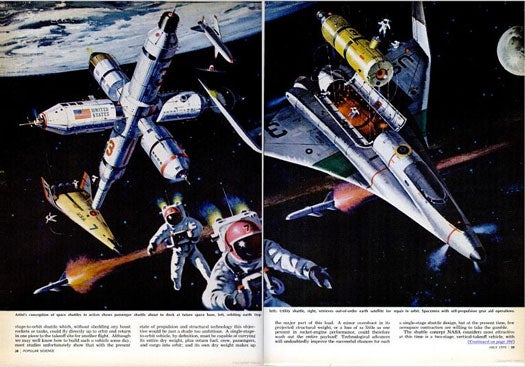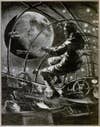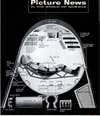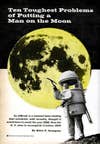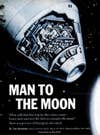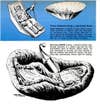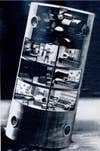Last Friday, we bade adieu to NASA’s 30-year Space Shuttle program as Atlantis lifted off for the very last time. Practical or not, the loss of our capacity for manned spaceflight is a little depressing for those of us who uphold interstellar travel as the paragon of human progress. While we can respect NASA’s decision to prioritize other projects, we can hardly fathom how something as futuristic as human space travel ended up becoming a part of our country’s past.
Ironically enough, the past can look a whole lot like a distant tomorrow when you study it through our 138-year archives. So until NASA can afford to send humans back into space, let’s reminisce on the agency’s golden age by flicking through our most dazzling space features.
Click to launch the photo gallery.
In 1919, we’d hardly begun the golden age of aviation, let alone the age of space travel, but we couldn’t look to the skies without wondering what it would be like to break through the atmosphere and soar among the stars. Illustrations from that period depict crew members floating in zero gravity while sporting the typical aviation garb: pilot caps, bomber jackets, and leather boots.
Forty years down the road, astronauts started looking more like they do today. Space technology progressed so quickly between those decades that if we continued at that rate, we’d likely have visited Mars by now. Consider how NASA sent a man to the moon just eleven years after it was founded. After the first manned moon landing, Dr. Wernher von Braun predicted that civilians would travel to space by the late 1970s. President Nixon’s formal endorsement of the Space Shuttle program further convinced him that humans would never by able to stay put on land.
“The old argument over manned vs. unmanned space flight would thus simply disappear,” von Braun wrote in 1972. “With manned, reusable shuttles providing cheaper transportation into orbit than any other system, the shuttle will corner the space-transportation market.”
Those sentences might be a little sad in retrospect, but as Rebecca wrote last week, there’s no reason to conclude that that the end of manned spaceflights marks the end of NASA. With endeavors like Juno’s mission to Jupiter and MSL’s rocket to Mars, it’s clear that progress endures and people prevail, albeit with their feet on the ground.
Click through our gallery to read about Apollo 11, the Space Shuttle’s debut, and the various musings of Dr. Wernher von Braun.
A Trip to the Moon: April 1919
It’s odd to think that the time between this imagining and the actual moon landing spans just fifty years, but that’s 20th-century progress for you. Here, esteemed science writer and future museum director Waldemar Kaempffert contemplated the logistics of space travel. How would a rocket overcome the Earth’s gravity? What kind of motor would propel us to the proper altitude? If we shot ourselves out of a giant cannon in the North Pole at a speed of 26,000 feet per second, as some had suggested, we’d end up being mere satellites. No, Kaempffert said, to ensure that we ended up on the moon and not floating aimlessly in space, we’d need a sophisticated “sky-rocket” — that is, a rocket with enough backward “kick” to shoot itself to the moon. With 25 minutes of motive force, the sky-rocket would hit an altitude of 3,600 miles. After that, it would travel on its own momentum. This wouldn’t be easy, of course. Kaempffert estimated the trip’s required amount of horsepower to be at least 414,000. No explosive, save for a few pounds of radium, could provide that much energy. Read the full story in “Hurling a Man to the Moon”
Spaceman: August 1958
If there’s one Popular Science feature that’s endured over the past decades, it’s Picture News (also known as “Megapixels” in recent years). In 1958, gave readers a sneak peek at the U.S. Air Force’s spaceflight training concepts. This one shows an orbital nose cone outfitted with a padded couch, a close-circuited atmosphere, and equipment that would monitor the astronaut’s vital signs before communicating them to ground forces. Read the full story in “Picture News: Man in Space”
Signaling With Sunbeams: May 1961
As anyone who has beheld the night sky knows, the vastness of space is as intimidating as the stars themselves. Embarking on a manned spaceflight entails traveling through a lot of emptiness before actually landing somewhere. How are astronauts supposed to communicate when sound waves can’t travel through that vacuum? Nowadays, astronauts use radio waves to communicate, but this article explored an old-fashioned, almost quaint solution: sunbeams and mirrors. The Air Force conducted several trials of Solar Orbital Communications (SOCOM) out in the Mojave Desert, where they concluded that it was worth exploring long-range sunbeam signals as an option for interstellar travel. Ideally, SOCOM system would use a giant transmitter to flash messages to relay stations in space. Just think of it as Morse Code with mirrors. Read the full story in “Spacemen May Talk on Beams of Light”
Manned Lunar Landing: February 1962
By the time we published this article, the U.S. government was intent on ensuring that we reached the moon first; after all, the Soviet Union had already caught us off guard when it launched Sputnik in 1957. In order to get there, however, we had to overcome a series of engineering challenges. First and foremost was the design of our craft. It not only needed enough power to reach the moon, but it would have to provide artificial gravity for our astronauts. Next was the duration of the trip. Would we go the direct ascent route or refuel at a space station? Other problems outlined in our top ten list dealt with building the launch pad, choosing a safe landing target, and re-entering the Earth’s atmosphere on the way back. In retrospect, it’s pretty impressive how NASA managed to figure these questions out in just seven years. Read the full story in “Ten Toughest Problems of Putting a Man on the Moon”
Conquering the Moon: April 1964
By 1964, a moon landing was imminent. To give readers a better idea of what would transpire, we gave them a play-by-play description of the mission’s flight, landing, and return. Curiously enough, we glossed over what the crewmen would actually do on the Moon once they landed. Perhaps at that point, we didn’t really know, but anyway, it was Ray Pioch’s characteristically 1960s illustrations that made this moon landing feature stand out from the rest. Read the full story in “Man to the Moon”
Lifeboats in Space: September 1966
With a venture as dangerous as manned spaceflight, engineers had to devise ways to ensure that the crew arrived home safely after an accident. Dr. Wernher von Braun told us about the Space Rescue Program, only became more urgent when a faulty thruster almost doomed the Gemini 8 crew. Like a sea rescue operation, rescuing astronauts would require special lifeboats that with enough provisions to keep crewmen alive. Two of these ideas are shown on the left. In the fist one, an ejector seat would shoot the crewman out of danger’s reach. A variation on this idea uses a filter-shaped skirt as a reverse parachute of sorts. Meanwhile, General Electric’s lifeboat would envelop the astronaut in a plastic cocoon equipped with a retrorocket and a heat shield for reentry. Read the full story in “Lifeboats in Space”
Walking in Space: February 1967
During NASA’s Apollo era, you could count on Dr. Wernher von Braun to not only consider every conceivable spaceflight question, but to give the most fantastic answers possible. This time, he considered the problem of walking in space. Getting used zero gravity was one thing, but how efficiently could we expect crewmen to work when they motor abilities were significantly compromised? Even with weightlessness training, von Braun explained, it would be challenging to keep astronauts from over-exerting themselves working outside of their spacecraft. Not to mention that spacesuits are hardly conducive to dexterity. Again, von Braun outlined a couple of ideas for dealing with the problem, including a maneuverable cage that could enable astronauts to build the a space station without all that inconvenient free-floating. Read the full story in “New Ideas Solve the Weird Problems of Space Walking”
At Home in Space: December 1969
We might have opted for a direct ascent during the first moon landing, but future missions to Mars could reasonably choose otherwise given the trip’s duration. Space travel isn’t comfortable, so why not put up our astronauts in a swanky space base? The orbiting station would contain separate quarters for laboratories, physical training, rest, control, and command. The top of the station would be used for docking and re-supplying shuttles. Read the full story in “For Tomorrow’s Spacemen, Home Away From Home”
Spaceplane: July 1970
In a grand display of optimism likely influenced by our success with Apollo 11, Dr. von Braun declared that by the late 1970s, civilians would ride spaceplanes out into orbit. A reusable shuttle would provide services as luxurious as those on a commercial jet, and the best of all, you wouldn’t even need to undergo years of grueling astronaut training. This illustration shows an artist’s concept of space tourism. While the yellow passenger shuttle on the bottom left prepares to dock at an orbiting space base, astronauts load a broken satellite into a the utility shuttle for repair. Read the full story in “The Spaceplane That Can Put YOU in Orbit”
Introducing the Space Shuttle: May 1972
At last, the Space Shuttle’s formal debut (as well as a future mooncraft illustration we couldn’t resist including). To help readers understand what the vehicle would entail, Dr. von Braun wrote that it would “take off like a rocket, fly in orbit like a spaceship, and land like an airplane.” The reusable shuttle would save us millions in transportation costs, he argued. Upon realizing the potential of a space shuttle, agencies would likely purchase “FOB units” that would deploy an activation crew with a shuttle carrying a satellite. That way, the crew could monitor its functionality and relay their observations back to the ground station. Von Braun also predicted that that the shuttle program would one day accommodate non-astronaut scientists to work in space laboratories. “The old argument over manned vs. unmanned space flight would thus simply disappear,” von Braun said. “With manned, reusable shuttles providing cheaper transportation into orbit than any other system, the shuttle will corner the space-transportation market.” Read the full story in “Space Shuttles Get the Green Light”
